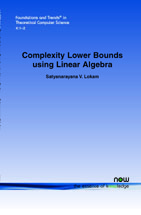Complexity Lower Bounds using Linear Algebra
By Satyanarayana V. Lokam, Microsoft Research India, India, satya@microsoft.com
Abstract
We survey several techniques for proving lower bounds in Boolean, algebraic, and communication complexity based on certain linear algebraic approaches. The common theme among these approaches is to study robustness measures of matrix rank that capture the complexity in a given model. Suitably strong lower bounds on such robustness functions of explicit matrices lead to important consequences in the corresponding circuit or communication models. Many of the linear algebraic problems arising from these approaches are independently interesting mathematical challenges.
Complexity Lower Bounds using Linear Algebra
While rapid progress has been made on upper bounds (algorithms), progress on lower bounds on the complexity of explicit problems has remained slow despite intense efforts over several decades. As is natural with typical impossibility results, lower bound questions are hard mathematical problems and hence are unlikely to be resolved by ad hoc attacks. Instead, techniques based on mathematical notions that capture computational complexity are necessary. Complexity Lower Bounds using Linear Algebra surveys several techniques for proving lower bounds in Boolean, algebraic, and communication complexity based on certain linear algebraic approaches. The common theme among these approaches is to study robustness measures of matrix rank that capture the complexity in a given model. Suitably strong lower bounds on such robustness functions of explicit matrices lead to important consequences in the corresponding circuit or communication models. Understanding the inherent computational complexity of problems is of fundamental importance in mathematics and theoretical computer science. Complexity Lower Bounds using Linear Algebra is an invaluable reference for anyone working in the field.
